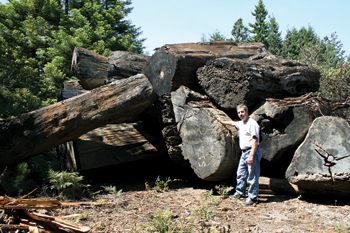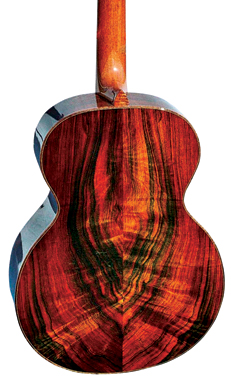|
 A Ryan Cathedral with a
sinker A Ryan Cathedral with a
sinker
redwood top.Most of these woods are available in traditionally
harvested form, so why go to the trouble of sourcing them
alternatively? Are luthiers just trying to save money? The
main reason for using recycled (previously processed for use
other than guitars) or reclaimed (salvaged from the beach,
forest floor, etc.) wood is that it can often be found in
higher quality than in recently grown and cut logs. Much of
this material has had many years of seasoning and may have
lots of character, too—features that are found in the finest
tonewoods. The fact that using these woods lowers the impact
on the planet makes them even more attractive.
Let's look at a few of the alternative ways that tonewood
is being harvested and how guitar builders are using recycled
wood in their instruments.
Take Me to the RiverBefore the use of powered
machinery (including Caterpillar tractors, "bull donkeys," and
"steam donkeys"), Northern California's coastal redwood logs
were floated down rivers to sawmills. Along the way, some logs
sank to the bottom, where they remained in the river silt for
100 years or more—thus the term "sinker." During this time an
interesting transformation occurred.
 Author Rick Micheletti with
reclaimed Author Rick Micheletti with
reclaimed
"sinker" redwood logs.Spurred by increasing prices for high-quality construction
lumber, wetsuit-clad salvagers spent hundreds of hours
searching for sinker logs on the cold river bottoms starting
in the late 1980s. Using small "barges" made from two
cylindrical pontoons connected by cross members with a winch
in the middle, they began to remove the sinker logs from the
murky river, with some of the wood ending up in the hands of
luthiers.
Salvage Sunburst
I've been creating guitar tops from a monstrous,
14-foot-long sinker redwood log I came across while visiting a
local sawmill in December of 2000. The log has fine,
consistent grain running its entire length, and a purple color
on one side, fading to reddish golden brown on the other. I
could immediately imagine the natural sunburst effect it would
create on a book-matched soundboard. I initially hesitated to
purchase the entire log, so I talked the sawyer into letting
me buy a two-foot section (which still left him with a log
that would yield 12-foot beams for building projects).
Once I'd cut and cured the wood, built a couple of guitars,
and gotten lots of "holy cow!" comments about the tone and
looks, I went back to the mill and bought the rest of the log.
I have since experimented with several different combinations
of back-and-sides woods. Some of my favorites combined the
redwood tops with salvaged rosewood back and sides, resulting
in a guitar built primarily from salvaged woods.
The Sinker SoundCompanies such as R. Taylor,
Breedlove, Ryan Guitars, and others have also constructed
instruments with sinker redwood tops. Kevin Ryan likes redwood
for top wood in general, whether it is sinker or not. "As a
result of its high strength-to-weight ratio, it really shines
at the upper registers like cedar, only a little darker," he
says. "It sounds great in big, open alternate tunings, and it
has a lush sound that fingerstylists really love. The sinker
has these lovely acoustic qualities but also happens to look
fabulous—and of course the story behind it is very
compelling."
Simon Fay, a luthier in New Smyrna Beach, Florida, has made
a number of guitars with sinker tops. "I have been able to get
very good clarity but also a tremendous amount of overtones,"
he says, adding that it combines some of the best qualities of
spruce and cedar.
Other Ways to Salvage RedwoodUnfortunately, the
salvaging of sinker redwood came to a halt in the mid-1990s.
There are still plenty of logs in the rivers, but salvaging
regulations (set up in part to protect salmon) now make the
cost of operations prohibitive. However, there is still a
large amount of this amazing material around. We can only hope
that future stream restoration projects will include the
removal of the remaining logs that never really belonged there
in the first place.
But other ways of salvaging redwood continue. In my home
county of Mendocino, California, some gigantic redwood trees
called "buckskins" have been salvaged from the forest floor.
These trees were felled over 100 years ago but were never
gathered for one of two reasons: the fallers would sometimes
get ahead of the gatherers, and there would not be enough
trees in the area to make moving the rigging used to haul the
logs out of the forest worthwhile; or the rigging simply
wasn't big enough to handle some of the giants that were
fallen. Since redwood is resistant to rot, many of these
giants are in a "perfect" state of preservation, and some of
this wood has found its way into the guitar-making world with
great success.
 Salvaged rosewood back and
sides Salvaged rosewood back and
sides
on a Micheletti guitar.Reclaiming Tonewoods
Brent Cole of Alaska Specialty Woods, located on Prince of
Wales Island, Alaska, has taken tree conservancy to a very
high plane. In the search for master-quality Sitka spruce
tops, he disassembles discarded Sitka spruce log bridges and
log floats as long as 100 feet, and even removes standing dead
trees or trees that have blown down in storms. Most of the
Sitka spruce he processes for 50,000 tops each year is from
salvaged logs. Not only does this type of operation conserve
our current tree population, it serves to clean the existing
forests, removing potential dry fuel for forest fires.
Dave Maize of Earth-Friendly Woods in Cave Junction,
Oregon, is a luthier and supplier of woods. Red and Port
Orford cedar (reclaimed from trees killed by fires), and Sitka
and Engelmann spruce (from trees that fell in storms or were
killed by bug infestation) are some of the materials that he
uses and offers. Using the good parts of these trees yields
excellent tops and stretches the supplies. For the backs and
sides of guitars, Maize uses claro walnut milled from trees
that were removed in urban areas and bay laurel driftwood
logs.
A widely publicized example of reclaiming wood involved
Taylor's Liberty Tree project. When the last surviving Liberty
Tree (a 400-year-old tulip poplar in Annapolis, Maryland) was
irreparably damaged by Hurricane Floyd in 1999, the
90-foot-tall living landmark became a safety hazard, and it
was cut down following a special ceremony. Taylor Guitars
purchased enough of the salvaged Liberty Tree wood to make a
limited-edition run of about 400 full-size guitars in 2002 and
followed up with another 400 or so special-edition Baby
Taylors. This year, the company began offering a line of
electric guitars using some of the remaining wood.
More to Come
This article only touches on a few "green" guitar
operations. Much more is certainly being done in the area of
wood recycling. And it's quite possible that even more
existing materials could be used in guitar construction. How
much tonewood is sitting out there in stumps, barns, bridges,
or underwater, just waiting to be turned into great guitars?
You can be sure that a number of resourceful people will
continue the hunt.
Photo credits:
Micheletti—courtesy Rick Micheletti. Ryan—courtesy of Ryan
Guitars. |
